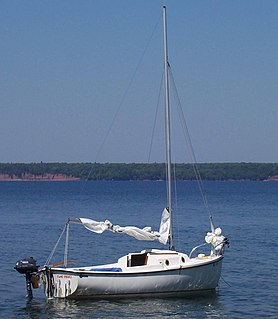Related Research Articles

The M Scow, also called the M-Scow and the M-16 Scow, is a Canadian/American sailing dinghy that was designed by Johnson Boat Works and Melges Boat Works as a one-design racer and first built in 1950.

The Tempest is a trailerable, one-design racing sailboat that was designed by British naval architect Ian Proctor and first built in 1965.
The Rhodes 19 is an American trailerable day sailer or sailing dinghy, that was designed by Philip Rhodes as a one-design racer and first built in 1958.

The Com-Pac 16 is an American trailerable sailboat that was designed by Clark Mills as a small cruiser and first built in 1972.
The Herreshoff 12½ Footer is a one-design keelboat.
The Cheshire 14 is an American catamaran sailing dinghy that was designed by Frank Meldau as a racer and first built in 1962.
The Herreshoff Bull's Eye or Bullseye, is an American trailerable sailboat that was designed by Nathanael Greene Herreshoff and first built in 1914.
The Dolphin 17 is an American trailerable sailboat that was designed by Glenn Corcoran and Murray Corcoran and first built in 1970.
The Vagabond 17 is an American trailerable sailboat that was designed by Ron Holder as a pocket cruiser and first built in 1976.
The Holder 17 is an American trailerable sailboat that was designed by Ron Holder as a pocket cruiser and day sailer and first built in 1982.

The Hampton One-Design is an American sailing dinghy that was designed by Vincent Serio as a one-design racer and first built in 1934.

The Mercury 18, sometimes just referred to as a Mercury, is an American sailboat that was designed by Ernest Nunes as a one design racer and first built in 1939. The boat was one of the first one-design sailboat classes designed for plywood construction.
The Cape Cod Mercury 15, also called the Mercury Sloop and just the Mercury, is an American trailerable sailboat and sailing dinghy, that was designed by Sparkman & Stephens and first built in 1940.
The Prindle 18 is an American catamaran sailing dinghy that was designed by Geoffrey Prindle as a racer and first built in 1977.
The Victoria 18 is an American trailerable sailboat that was designed by Canadian G. William McVay. It was built in the United States 1977 to 1983.
The Impulse 21, also called the Impulse Eagle, is an American trailerable sailboat that was designed by William E. Cook as a one-design racer and day sailer, It was first built in 1986.
The Stuart Knockabout is an American trailerable sailboat that was designed as a daysailer, by L. Francis Herreshoff and first built in 1932. The boat is L.F. Herreshoff design number 53.
The Marlin 23, also called the Marlin Heritage, is an American trailerable sailboat that was designed by Nathanael Greene Herreshoff and A. Sidney DeWolf Herreshoff, first built in 1958.
The Herreshoff Rozinante is an American trailerable sailboat that was designed by L. Francis Herreshoff as a daysailer and cruiser and first built in 1952.
The Herreshoff Goldeneye is an American trailerable sailboat, designed as a day sailer and cruiser and first built in 1959. The hull lines were designed by Nathanael Greene Herreshoff and the rig by A. Sidney DeWolf Herreshoff.
References
- 1 2 3 4 5 McArthur, Bruce (2020). "Buzzards Bay 14 sailboat". sailboatdata.com. Archived from the original on 1 December 2020. Retrieved 1 December 2020.
- ↑ McArthur, Bruce (2020). "L. Francis Herreshoff". sailboatdata.com. Archived from the original on 6 October 2020. Retrieved 5 October 2020.
- 1 2 3 4 5 6 Sherwood, Richard M.: A Field Guide to Sailboats of North America, Second Edition, pages 88-89. Houghton Mifflin Company, 1994. ISBN 0-395-65239-1
- ↑ McArthur, Bruce (2020). "Concordia Company". sailboatdata.com. Archived from the original on 5 July 2020. Retrieved 5 October 2020.
- ↑ Buzzards Bay Boat Shop. "The Boat: Buzzards Bay 14". buzzardsbayboatshop.com. Archived from the original on 6 October 2020. Retrieved 5 October 2020.
- ↑ Artisan Boatworks. "Buzzards Bay 14 by L. F. Herreshoff". artisanboatworks.com. Archived from the original on 6 October 2020. Retrieved 5 October 2020.